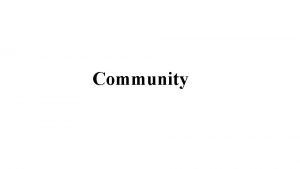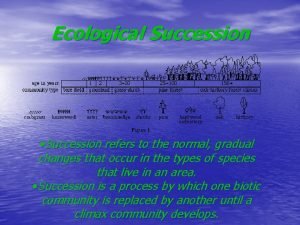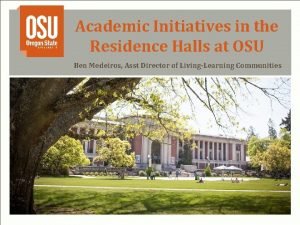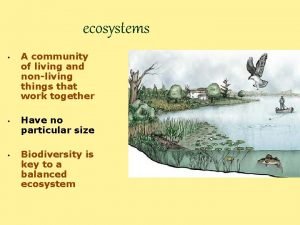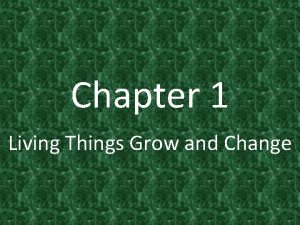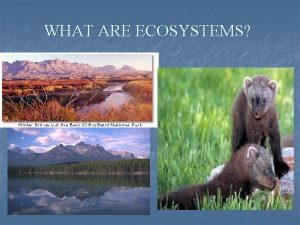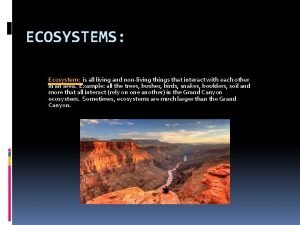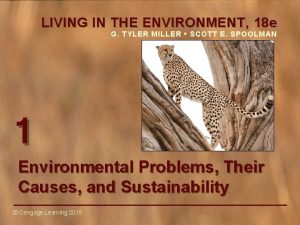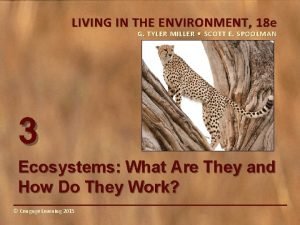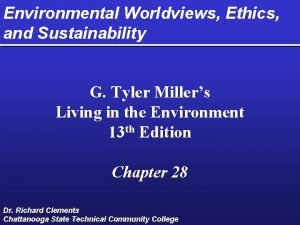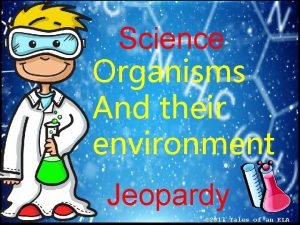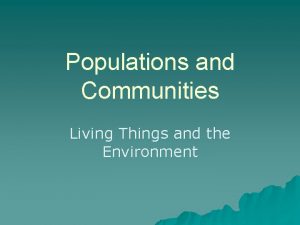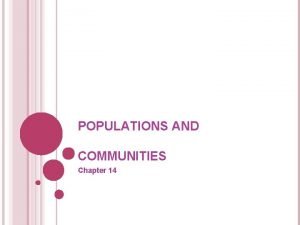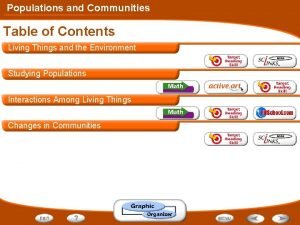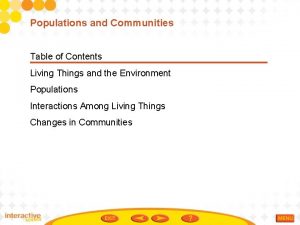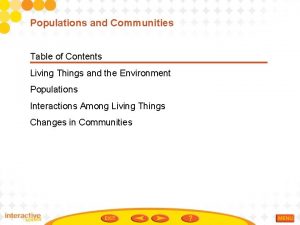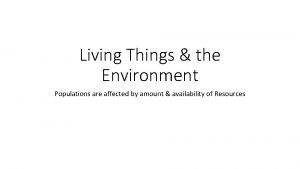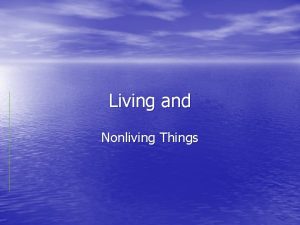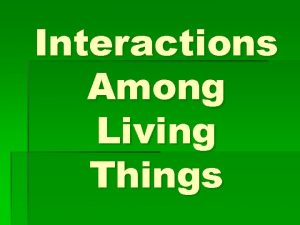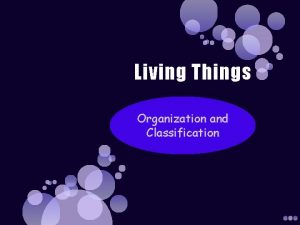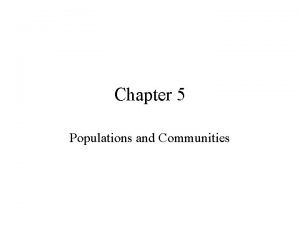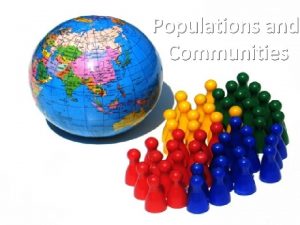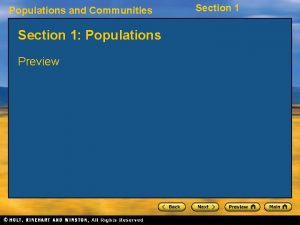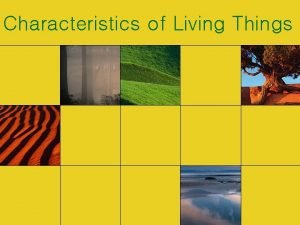Living Things and the Environment Populations and Communities




















- Slides: 20

Living Things and the Environment

Populations and Communities • Population: all the organisms of the same species that live in the same area at the same time. • Community: all the populations living in an ecosystem at the same time. • Niche: the way a species interacts with the living and nonliving elements of the environment.

Population Size The size of fish population can change in several different ways: As fish die the population gets smaller The fish population increases as more fish hatch or move into the area Some fish might leave the population by moving to another location Some fish are caught or eaten, reducing the population The ecosystem might change and alter the population

Population Density • This describes the number of organisms in the population relative to the amount of space available. • A very dense population might have one fish for every few cubic meters of water

Limiting Factors These are factors that can limit the growth of a population: Biotic Potential: the potential growth of a population if it could grow in perfect conditions with no limiting factors. Carrying Capacity: is the largest number of individuals of one species that an ecosystem can support over time. Overpopulation: is when a population’s size grows beyond the ability of the area to support it.

Communities All the populations of a given area is a community. The organisms interact with abiotic and biotic factors in different ways.

Habitat A prairie dog is one type of organism, or living thing. Different types of organisms must live in different types of environments. An organism obtains food, water, shelter, and other things it needs to live, grow, and reproduce from its environment. An environment that provides the things the organisms needs to live, grow, and reproduce is called its habitat. A niche is the way a species interacts with the living and nonliving elements of the environment.

The relationship that the organisms have with each other in order to survive is called… SYMBIOSIS A close relationship between two organisms in which one organism lives near, on, or even inside another organism and in which at least one organism benefits.

So, what does all that mean? • Symbiosis comes from the Greek words sym, meaning “together”, and bios, meaning life.

Symbioses are placed into three categories: • Mutualism • Parasitism • Commensalisms

MUTUALISM • Both organisms benefit from the relationship.

How are these two creatures in a mutual relationship?

An example of mutualism • A small insect called an aphid is taken care of by a species of ants in exchange for meals of honeydew, which the aphid releases and the ant eats. The ant moves the aphid from leaf to leaf in exchange for the sweet honeydew. The ant protects the aphid from the weather and any aphiddevouring animals.

This is very interesting!! • The best example of mutualism involve microorganisms that live inside, yes, INSIDE the body of much larger partners. • In return, they help their partner in some way. • Bacteria that live inside your digestive system help to produce certain vitamins that your body needs.

PARASITISM • One organism benefits and the other is harmed.

These are just a few examples of parasites that live on or in a much larger host.

Special Note • Ecologists often regard parasitism and predation as being different forms of the same basic kind of interaction. • In predation and almost all examples of parasitism one organism eats another organism. • In predation, the predator usually kills its prey before it eats it. • In parasitism, the PARASITE usually lives on or in a much larger organism and feeds on it while it is still alive. The parasite’s unlucky “partner” is called its HOST. • Parasites usually do not kill their host, although many weaken it greatly.

In a most parasitism relationships the parasite does not kill its host, however… • A certain wasp lay its eggs on caterpillars. The eggs hatch into wormlike young wasps that burrow into the body of the caterpillar. The young wasps feed on the caterpillar’s tissues, avoiding the caterpillar’s major organs so that it stays alive. After about 30 -40 days, the young wasps chew their way out of the dying host’s body and spin cocoons. • Cuckoos and a few other type of birds lay their eggs in other birds’ nest. When the baby cuckoo hatches, it pushes the eggs and young of its foster parents out of the nest. The foster parents are tricked into feeding and caring for the intruder as if it were their own offspring.

COMMENSALISM • ONE OF THE ORGANISMS BENEFITS AND THE OTHER IS NOT HARMED BY THE ASSOCIATION.

Examples of commensalisms • An osprey ( a large hawk) builds its nest high in the branches of a tree. Smaller birds like sparrows and wrens build their nest under the osprey’s for protection from their enemies. • Dozen of tiny mites live at the base of the hairs that make up your eyebrows. You can not see them, they are microscopic. Don’t worry, everyone has them!
 Ecosystem living and nonliving things
Ecosystem living and nonliving things The smallest living unit within the human body is
The smallest living unit within the human body is Type of succession
Type of succession Movement life process
Movement life process Society is a large number of people living together in an
Society is a large number of people living together in an A gradual change in a community over time.
A gradual change in a community over time. Climax stage of succession
Climax stage of succession Osu living learning communities
Osu living learning communities Is tomato living or nonliving
Is tomato living or nonliving Living non living dead
Living non living dead Ecosystem living and nonliving things
Ecosystem living and nonliving things Parasitism
Parasitism What part of the plant carries and protects the seed
What part of the plant carries and protects the seed Single celled and multi celled organisms
Single celled and multi celled organisms Changes in living things
Changes in living things Non living things in grassland
Non living things in grassland Tropical rainforest living and nonliving things
Tropical rainforest living and nonliving things Living in the environment
Living in the environment Living in the environment 18th edition
Living in the environment 18th edition Earth centered worldview
Earth centered worldview Living environment jeopardy
Living environment jeopardy




